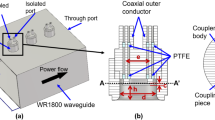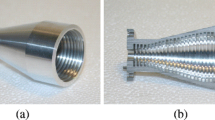Abstract
Everyone recognizes the need to drive symmetric quasioptical antennas in a symmetric way to maintain clean antenna patterns; in this note we report on the advantages of bringing out the IF in a symmetric (balanced) way as well. The main difference in IF circuits between waveguide and open structure mixers is that the quasioptical mixers are usually also open at IF wavelengths, so IF currents can flow on the outside of the mixer mounting structures. We measured these surface currents and their associated resonances on a scale model of our mixer block for a 690 GHz SIS mixer. Bringing the IF off the mixer with a balanced circuit solves the surface current problems, yielding a broad bandwidth with predictable impedances. We successfully tested an octave bandwidth IF matching circuit for open structure mixers that incorporates a commercial 180° hybrid at cryogenic temperatures. We also found that surface currents are not significant for corner cube mixers because they generate their own balancing currents.
Similar content being viewed by others
References
Eckart, A., Harris, A.I., and Wohlleben, R. 1988, “Scaled Model Measurements of the Sandwiched V-Antenna,”Int'l J. IR and mm Waves 9, 505.
Emerson and Cuming, Canton, MA.
Bowman, D.F. 1961, ch. 31 in “Antenna Engineering Handbook,” ed. H. Jasik, McGraw-Hill: New York.
Bawer, R., and Wolfe, J.J. 1960, “A Printed Circuit Balun for Use with Spiral Antennas,”IRE Trans. MTT-8, 319.
Oltman, G. 1966, “The Compensated Balun,”IEEE Trans. MTT-14, 112.
Laughlin, G.J. 1976, “A New Impedance-Matched Wide-Band Balun and Magic Tee,”IEEE Trans. MTT-24, 135.
Phelan, H.R. 1970, “A Wide-Band Parallel-Connected Balun,”IEEE Trans. MTT-18, 259.
Duncan, J.W., and Minerva, V.P. 1960, “100∶1 Bandwidth Balun Transformer,”Proc. IRE 48, 156.
Tzu-hung Chen et al. 1991, “Broadband Monolitic Passive Baluns and Monolithic Double-Balanced Mixer,”IEEE Trans. MTT-39, 1980.
Schiek, B., and Köhler, J. 1976, “An Improved Microstrip-to-Microslot Transition,”IEEE Trans. MTT-24, 231.
Mini-Circuits, Brookline, NY, model ZFSCJ-2-1-S.
Terman, F.E. 1943, “Radio Engineers' Handbook,” p. 53, McGraw-Hill: New York.
M/A-Com, Control Components Division, Merrimack, NH, model 2031-6331-00.
Harris, A.I., Jaffe, D.T., Stutzki, J. and Genzel, R. 1987, “The UCB/MPE Cassegrain Submillimeter Heterodyne Spectrometer,”Int'l J. IR and mm Waves 8, 857.
Author information
Authors and Affiliations
Rights and permissions
About this article
Cite this article
Harris, A.I., Schuster, K.F. & Tacconi, L.J. Broadband IF matching for quasioptical mixers. Int J Infrared Milli Waves 14, 715–728 (1993). https://doi.org/10.1007/BF02209277
Received:
Issue Date:
DOI: https://doi.org/10.1007/BF02209277




